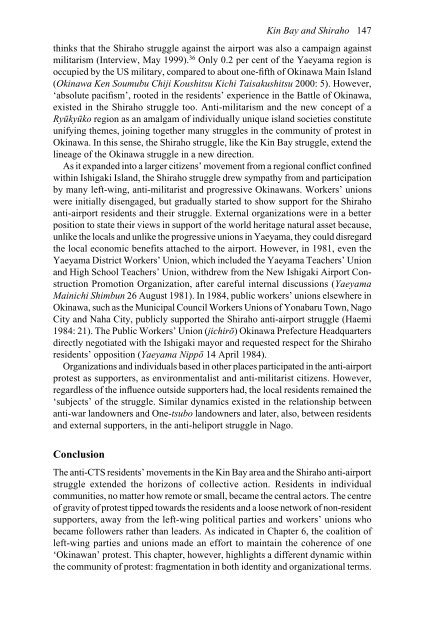Myth, Protest and Struggle in Okinawa
Myth, Protest and Struggle in Okinawa
Myth, Protest and Struggle in Okinawa
Create successful ePaper yourself
Turn your PDF publications into a flip-book with our unique Google optimized e-Paper software.
th<strong>in</strong>ks that the Shiraho struggle aga<strong>in</strong>st the airport was also a campaign aga<strong>in</strong>st<br />
militarism (Interview, May 1999). 36 Only 0.2 per cent of the Yaeyama region is<br />
occupied by the US military, compared to about one-fifth of Ok<strong>in</strong>awa Ma<strong>in</strong> Isl<strong>and</strong><br />
(Ok<strong>in</strong>awa Ken Soumubu Chiji Koushitsu Kichi Taisakushitsu 2000: 5). However,<br />
‘absolute pacifism’, rooted <strong>in</strong> the residents’ experience <strong>in</strong> the Battle of Ok<strong>in</strong>awa,<br />
existed <strong>in</strong> the Shiraho struggle too. Anti-militarism <strong>and</strong> the new concept of a<br />
Ryūkyūko region as an amalgam of <strong>in</strong>dividually unique isl<strong>and</strong> societies constitute<br />
unify<strong>in</strong>g themes, jo<strong>in</strong><strong>in</strong>g together many struggles <strong>in</strong> the community of protest <strong>in</strong><br />
Ok<strong>in</strong>awa. In this sense, the Shiraho struggle, like the K<strong>in</strong> Bay struggle, extend the<br />
l<strong>in</strong>eage of the Ok<strong>in</strong>awa struggle <strong>in</strong> a new direction.<br />
As it exp<strong>and</strong>ed <strong>in</strong>to a larger citizens’ movement from a regional conflict conf<strong>in</strong>ed<br />
with<strong>in</strong> Ishigaki Isl<strong>and</strong>, the Shiraho struggle drew sympathy from <strong>and</strong> participation<br />
by many left-w<strong>in</strong>g, anti-militarist <strong>and</strong> progressive Ok<strong>in</strong>awans. Workers’ unions<br />
were <strong>in</strong>itially disengaged, but gradually started to show support for the Shiraho<br />
anti-airport residents <strong>and</strong> their struggle. External organizations were <strong>in</strong> a better<br />
position to state their views <strong>in</strong> support of the world heritage natural asset because,<br />
unlike the locals <strong>and</strong> unlike the progressive unions <strong>in</strong> Yaeyama, they could disregard<br />
the local economic benefits attached to the airport. However, <strong>in</strong> 1981, even the<br />
Yaeyama District Workers’ Union, which <strong>in</strong>cluded the Yaeyama Teachers’ Union<br />
<strong>and</strong> High School Teachers’ Union, withdrew from the New Ishigaki Airport Construction<br />
Promotion Organization, after careful <strong>in</strong>ternal discussions (Yaeyama<br />
Ma<strong>in</strong>ichi Shimbun 26 August 1981). In 1984, public workers’ unions elsewhere <strong>in</strong><br />
Ok<strong>in</strong>awa, such as the Municipal Council Workers Unions of Yonabaru Town, Nago<br />
City <strong>and</strong> Naha City, publicly supported the Shiraho anti-airport struggle (Haemi<br />
1984: 21). The Public Workers’ Union (jichirō) Ok<strong>in</strong>awa Prefecture Headquarters<br />
directly negotiated with the Ishigaki mayor <strong>and</strong> requested respect for the Shiraho<br />
residents’ opposition (Yaeyama Nippō 14 April 1984).<br />
Organizations <strong>and</strong> <strong>in</strong>dividuals based <strong>in</strong> other places participated <strong>in</strong> the anti-airport<br />
protest as supporters, as environmentalist <strong>and</strong> anti-militarist citizens. However,<br />
regardless of the <strong>in</strong>fluence outside supporters had, the local residents rema<strong>in</strong>ed the<br />
‘subjects’ of the struggle. Similar dynamics existed <strong>in</strong> the relationship between<br />
anti-war l<strong>and</strong>owners <strong>and</strong> One-tsubo l<strong>and</strong>owners <strong>and</strong> later, also, between residents<br />
<strong>and</strong> external supporters, <strong>in</strong> the anti-heliport struggle <strong>in</strong> Nago.<br />
Conclusion<br />
K<strong>in</strong> Bay <strong>and</strong> Shiraho 147<br />
The anti-CTS residents’ movements <strong>in</strong> the K<strong>in</strong> Bay area <strong>and</strong> the Shiraho anti-airport<br />
struggle extended the horizons of collective action. Residents <strong>in</strong> <strong>in</strong>dividual<br />
communities, no matter how remote or small, became the central actors. The centre<br />
of gravity of protest tipped towards the residents <strong>and</strong> a loose network of non-resident<br />
supporters, away from the left-w<strong>in</strong>g political parties <strong>and</strong> workers’ unions who<br />
became followers rather than leaders. As <strong>in</strong>dicated <strong>in</strong> Chapter 6, the coalition of<br />
left-w<strong>in</strong>g parties <strong>and</strong> unions made an effort to ma<strong>in</strong>ta<strong>in</strong> the coherence of one<br />
‘Ok<strong>in</strong>awan’ protest. This chapter, however, highlights a different dynamic with<strong>in</strong><br />
the community of protest: fragmentation <strong>in</strong> both identity <strong>and</strong> organizational terms.
















